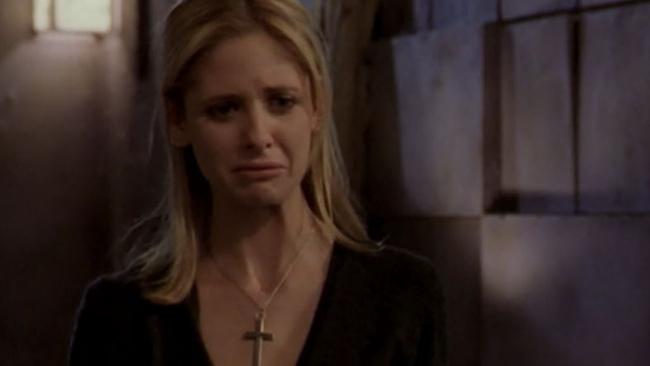Why Buffy still matters 19 years on
ALMOST 20 years since it first debuted, Buffy is still a phenomenon. Just ask anyone who went to the BingeFest marathon.

AT THE ungodly hour of 10.30pm on Saturday night, almost 350 people gathered in the foyer of Sydney Opera House’s Playhouse theatre.
There was a buzz and excitement in the air. Mostly people in their 30s, some of the assembled crowd clutched pillows and snacks, ready to bunker down for a seven-and-a-half-hour marathon of Buffy the Vampire Slayer.
Yes, responsible adults past their bedtime had congregated to watch a TV show with strangers in a not entirely comfortable theatre (with seats that really are too small to accommodate a pillow).
A TV show we loved as teenagers, a TV show we have probably watched a dozen times and no doubt own, at the very least, the complete collectors’ edition DVDs that originally cost $160 per season.
Maybe it was for the nostalgia, maybe it was to be in a space with like-minded souls, but for whatever reason, we came, we laughed, we cried and we screamed.
As part of the Opera House’s inaugural BingeFest, the Buffy marathon hosted by the A.V. Club was the first session to sell out and there were few empty seats in the auditorium by the time the lights went down.
It may sound incredible to outsiders, but this is the kind of fandom that comes with any Buffy event anywhere in the world. Almost 20 years after it first aired in 1997, Buffy still inspires the kind of adulation that has spawned countless books, conferences, fan fiction and PhDs.

Buffy started out around a time online communities first started to come together to pore over every detail of their favourite shows, when it was still a group of viewers visiting geocities fan sites on their dial-up modems, before almost every TV show was recapped within hours of its broadcast on mainstream news sites.
Here in Australia, Buffy first debuted on Channel 7 in late 1997 when networks used to try out new American TV shows during the summer non-ratings period, shows they weren’t convinced were going to fire during the year. Buffy never really caught on for a mainstream audience down here, eventually, sporadically, relegated to a 10.30pm Monday night timeslot months and months behind the US schedule.
My friend Rachael and I spent a decent part of our early high school years obsessing over every aspect of the show, our hearts broke when Angel broke Buffy’s, we cheered when she took down the Master and his fruit-punch mouth and we cried when she sent a newly re-ensouled Angel to hell.
We used to hit the computer labs in our school during lunch breaks and print off black-and-white cast photos to stick on our school books and in our lockers.
And because Channel 7 was so late in airing the new episodes, we’d found a website that posted the Buffy scripts of new episodes soon after it aired in the US, which meant that we read the clever dialogue of the show’s second season well before we ever heard them on screen.
Much was been written and said about why Buffy resonated so strongly with so many people throughout the years — that its “high school as hell” metaphor captured the raw emotional rollercoaster that plagued teens around the world with the literal demons standing in for our personal demons.

That it featured this kickarse, quippy but flawed teenage female hero who subverted so many genre and life conventions was just part of what made it the phenomenon it became.
For me, Buffy was the first ever show that made me realise that TV was more than just entertainment — that it could be meaningful, that it could be personally relevant and that this form of layered storytelling was worthy of being analysed and worshipped.
But most importantly, that TV was a way for people to connect and come together.
Which is why 350 adults gathered on a Saturday night to watch seven episodes of Buffy together — episodes chosen to showcase the series’ heart, humour and innovative, successful formalist experiments.
While some of the earliest episodes don’t hold up well in today’s Golden Age of TV, as a whole, Buffy remains an influential force in TV, an antecedent to the many strong female characters that came after.
My friend Rachael couldn’t make it to the marathon (she’s pregnant with her second child) but my workmate Rashell Habib was sitting right next to me, shedding tears as Buffy plunged that sword into Angel. Somewhere else in the audience, unbeknown to me at the time, was someone I went to high school with who used to record Foxtel’s re-run episodes of Buffy’s first season on VHS for me.
I later saw on Twitter that she made it all the way through to the end, proudly holding on to her “graduation certificate” as the sun rose in the background. I was a wuss and bailed at 1.30am.
But for those few hours, we were all teenagers again, watching our hero save the world. A lot.
Continue the conversation on Twitter with @wenleima.




